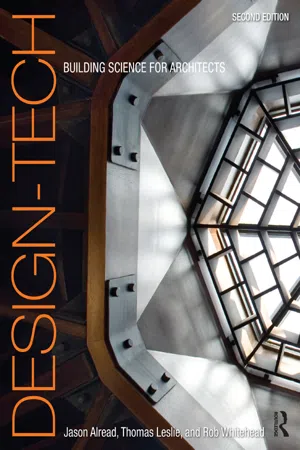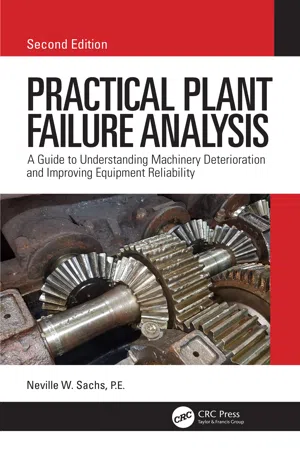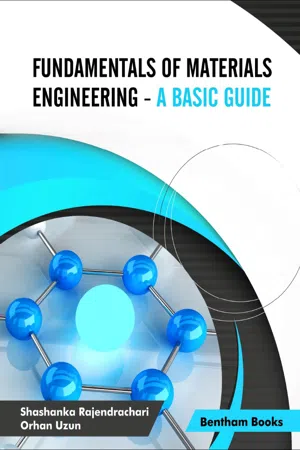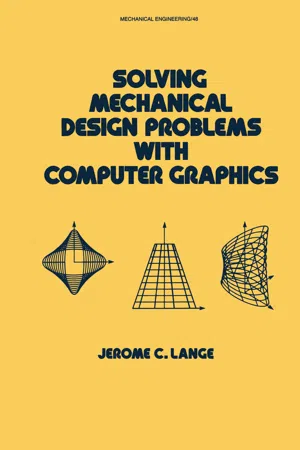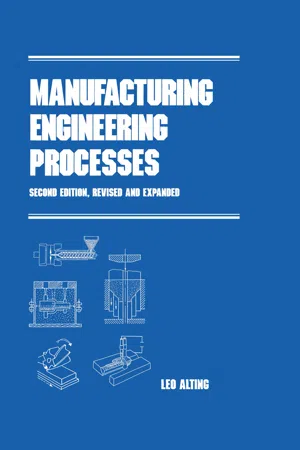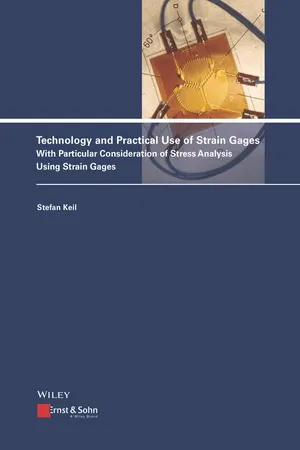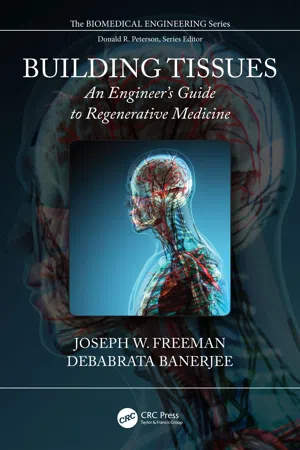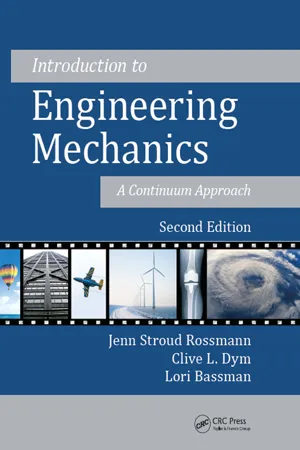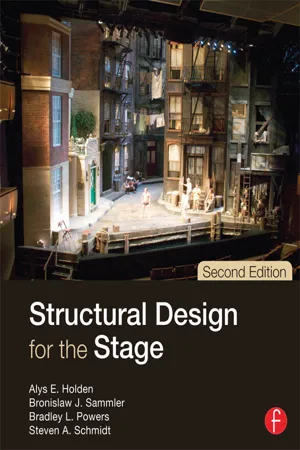Technology & Engineering
True Stress and Strain
True stress and strain are measures used in materials engineering to account for the change in cross-sectional area and length of a material as it undergoes deformation. True stress takes into consideration the actual cross-sectional area at any given point during deformation, while true strain accounts for the actual change in length of the material. These measures provide a more accurate representation of a material's behavior under load.
Written by Perlego with AI-assistance
Related key terms
Related key terms
1 of 4
Related key terms
1 of 3
12 Key excerpts on "True Stress and Strain"
- eBook - ePub
Art Conservation
Mechanical Properties and Testing of Materials
- W. (Bill) Wei(Author)
- 2021(Publication Date)
- Jenny Stanford Publishing(Publisher)
This is a process known as necking (see Fig. 2.15). The force required to continue deforming the specimen thus decreases. This means that the stress calculated using the original load carrying area, A 0, σ = F/A 0, decreases as we see in the stress-strain curves. If we were to calculate the stress based on the momentary force and cross-section area based on the Poisson effect, the so-called true stress, we would find that the stress increases all the way to final failure since most engineering applications only require knowledge of the stress-strain curve up to σ UTS, or only the material strength, using the original area, A 0, provides enough accuracy. The stress-strain curves which we have been showing and are commonly used are aptly known as engineering stress-strain curves. For fundamental research on materials properties, the true stress and thus true stress-stain diagrams are used, which require more experimental effort to measure than described in Section 4.1. In this book, we will always refer to stress as the engineering stress. Figure 2.15 Necking of a tensile specimen. (a) Before loading. (b) Necking just before final failure. Typical ranges of values for the yield strength, ultimate tensile strength and/or E -modulus of a number of classes of materials which one typically comes across in art and objects conservation are shown in Table 2.3. These values are far from all-inclusive and are only meant to provide a feel for mechanical properties data - eBook - ePub
Design-Tech
Building Science for Architects
- Thomas Leslie, Robert Whitehead(Authors)
- 2014(Publication Date)
- Routledge(Publisher)
r = 0.658″ or approx. 5/8″Designers can use this information to evaluate the ramifications on the sizing and spacing of support elements if any of the design factors were to change. For instance, because the load and component size (area) are directly proportional, if the spacing of the cables were to double (thereby doubling the tributary area), the area of the cable would also have to double (although because it is a circle, doubling the area doesn't double the radius).However, in these examples we are only evaluating an element based on its capacity to carry a load, in other words, its strength. Under stress, each element will also deform, and so the relative value of a material's stiffness also needs to be evaluated.Stresses and Strains
Loads cause stress (tension, compression, bending or torsion) and stresses deform or strain supporting members. In the simplest terms, stress is what is felt, strain is what happens as a result. Different types of stress cause different types of deformations to occur. Initially we will focus on the strains caused by the axial stresses of tension and compression. If an object is pulled or pushed under loading it changes from its original shape by becoming shorter or longer—these strains are often too small to see, but the change does occur.Simply put, strain, s, is a measure of an object's change in length (defection), e, compared to its original length, L, as described in the equation.s = e / LIn 1678, Robert Hooke, an associate of London architect Christopher Wren, discovered two key laws of structural behavior related to stress and strain.First, he found that the strain of a material is always proportional to the stress it undergoes, or in Hooke's words, “Ut tensio, sic vis” (“As the elongation, so is the force”). This means that doubling the force on a given structural member will double its deformation (Figure 21.4 - eBook - ePub
Practical Plant Failure Analysis
A Guide to Understanding Machinery Deterioration and Improving Equipment Reliability, Second Edition
- Neville W Sachs, P.E.(Authors)
- 2019(Publication Date)
- CRC Press(Publisher)
3 Materials and the Sources of Stresses- A. Stress, Strain, and Material Strength
- B. Mechanical Stress
- C. Thermal Stress
Some very basic failure analyses can be accomplished without truly understanding the effects of various stresses and the materials they act on. Unfortunately, as failures become more complicated, this lack of knowledge almost always leads to serious errors and, when one starts looking into more costly or more complex failures, the need to understand exactly what is happening is incredibly valuable.Stress causes parts to bend or break, but all materials don’t react in the same manner. In the real world, a good understanding of stresses and their effects on materials is crucial to accurate failure analysis. (For example, doubling the load on a beam could cause it to deflect twice as much or it could cause an immediate catastrophic failure. But the effect of doubling the load on a rolling element bearing is that its life will be cut by a factor of eight to ten.) In this chapter, we’ll discuss some of those basic definitions and concepts.Stress
When a load is put on a part, the part is stressed . Figure 3.1 shows a block with a cross-section area of 645 mm2 (1 in2 ). With the load of 50,000 N (11,240 pounds), the resultant tensile stress is 77.5 MPa or 11,240 lbs/in2 .In this example, the block is axially loaded and the piece is in tension . In a similar manner, reversing the forces shown here would put the piece in compression. To calculate the magnitude of the stress in the block shown in Figure 3.1 the formulas = p / ais used. In this equation s is the pressure or stress (in MPa or pounds per square inch), p equals the load (in newtons or pounds-force), and a is the stressed area (in square mm or square inches).If the same block were to be subjected to a bending load or a bending moment the stress would be very different as seen in Figure 3.2 . The block in Figure 3.1 is subjected to pure tension and the stress is uniform across it but, as shown in Figure 3.2 - Shashanka Rajendrachari, Orhan Uzun(Authors)
- 2021(Publication Date)
- Bentham Science Publishers(Publisher)
Original Gauge Length: Before conducting the tensile tests, two permanent marks are made on the test specimen at an appropriate distance called “Original gauge length”. By subtracting the original gauge length (before the test) with final gauge length (after the test) will give the extent of tensile strength of the tested specimen.3. ENGINEERING STRESS-STRAIN CURVES
The stress-strain curves can be obtained during testing a specimen. As we proceed with the test, the length of the specimen increases and the cross-sectional area decreases; but it is assumed here that dimension remains unchanged. Therefore, engineering stress and engineering strain can be explained by the following equations;The load-bearing capacity of materials is called loadability. This is one of the important mechanical properties which decide the strength of materials. The loadability of materials can be studied by using a tensile testing machine (Universal testing machine) by plotting the engineering stress-strain curve. The engineering stress-strain curve is the same as that of the load-extension diagram. This is because, if the parameters on X-axes and Y-axes are divided by some constants, the original diagram remains unchanged. Therefore, only scales on the X and Y-axes will change, but the original diagram remains unaffected. If we divide the extension (X-axis) by the original gauge length, then the property becomes ‘strain'. Similarly, if we divide the load (Y-axis) by the original area, then the property becomes ‘stress’. Therefore, the load-extension diagram and engineering stress-strain diagrams are the same.4. TRUE STRESS-STRAIN CURVES
During the tensile test, the specimen will be pulled apart slowly under applied load until it breaks. The specimen will behave differently from the start of the test until it breaks. These curves can be plotted by using the values of true stress and true strain generated instant to instant during the tensile test. Therefore, it will undergo different phenomena during the test, and it can be divided into four phases or regions, as illustrated in Fig. () [34- Jerome Lange(Author)
- 2021(Publication Date)
- CRC Press(Publisher)
Stress and Strain4.1 STRESSStress is force divided by area, in the limit as the area approaches zero. For example, Fig. 4.1a shows a force dF which is exerted on an area dA on the end of a rectangular bar. The stress is a = dF/dA. Figure 4.1b shows the distribution of force over the entire end of the bar. Here the total is the sum of the forces dF, and the total area is the sum of the areas dA. Stress is usually expressed in pounds per square inch, which is often abbreviated as psi. Stress is a vector.FIGURE 4.1aFIGURE 4.1bNormal stress is stress for which the vector is normal, or perpendicular, to the area on which it acts. The stress represented in Fig. 4.1a is a normal stress. Normal stress is represented here by a (sigma).A normal stress is called a tensile stress (or tension) when it stretches the material on which it acts, as in Fig. 4.2a . A tensile stress is usually taken to be positive.FIGURE 4.2(a) Tensile stress; (b) compressive stress.A normal stress is called a compressive stress (or compressive) wheji it shortens the material on which it acts, as in Fig. 4.2b . A compressive stress is usually taken to be negative.Shear stress is stress for which the vector is tangent to the area on which it acts. Figure 4.3 shows a shear stress acting on the end of a bar. Shear stress is represented here by t (tau).FIGURE 4.3Shear stress.4.2 STRAINStrain is deformation divided by the length in which the deformation occurs. Since strain is a length divided by a length, it is dimensionless. Strain is a vector.Normal strain- Alting(Author)
- 2020(Publication Date)
- CRC Press(Publisher)
Chapter 3 . However, this assumption will not lead to any serious discrepancies at this level.A short introduction to two- and three-dimensional systems of stress is fol- lowed by discussions of the stress-strain curve, true stress, logarithmic or nat- ural strain, volume constancy, and instability. Finally, the yield criteria, which determine the stresses necessary to initiate and maintain plastic flow and the work necessary to carry out the deformation, are analyzed.4.2 TWO- AND THREE-DIMENSIONAL SYSTEMS OF STRESS
The forces that act on a solid body may be classified as either volume or mass forces or surface forces. Volume or mass forces , which include acceleration forces, are not considered in this discussion because they are usually negligible in metalworking processes. Surface forces include forces acting on the surface of every volume element, transmitted either by the interaction of the surrounding material or by external forces.When analyzing design situations for dimensioning purposes or forming pro- cesses for planning or design purposes, it is more appropriate to use the force per unit area as a measure of the load rather than the total force distributed over the area.The force per unit area (described in Chapter 2 ) is called the stress and is usually designated by the symbol σ (sigma):σ =force area( 4.1 )Considering the tensile specimen shown in Fig. 4.1 , the stress on a cross section (1) perpendicular to the longitudinal axis is defined byFIGURE 4.1 A tensile specimen with the cross-sectional area A subjected to the load P .σ =P A( 4.2 )where P is the force and A is the cross-sectional area.If a cross section (2) that is inclined at an angle θ to the longitudinal axis is considered, the mean oblique stress σm is found to beσ m=P=A θP Asin θ( 4.3 )where A θ is the cross-sectional area of cross section 2. This stress [<σ, Eq. (4.2 )] lies in the direction of the longitudinal axis of the specimen. The force P can be resolved or decomposed into two components P n perpendicular to cross section (2) and P t- eBook - ePub
Technology and Practical Use of Strain Gages
With Particular Consideration of Stress Analysis Using Strain Gages
- Stefan Keil(Author)
- 2017(Publication Date)
- Ernst & Sohn(Publisher)
Here it must be emphasized that it is impossible to measure stress with strain gages. We are able to measure the strain with high accuracy, but the estimation of stress requires calculation methods based on appropriate material laws. Now we will consider stress calculation from the measured strain using strain gages. This assumes the ability to carry out satisfactory strain measurements with strain gages.Stress analysis as considered here is limited to the elastic deformation range of materials, where strain is proportional to stress and is reversible. After load relief in the elastic deformation range the material returns to its original form. Most analyses using strain gages are limited to the elastic deformation range; in these cases the deformation of the material under study does not reach the yield point.Stress analysis using strain gages is also feasible in the elastoplastic deformation range of the material. In this range reversible (elastic) deformation as well as irreversible (plastic) deformation occurs. Therefore the stress is no longer proportional to the strain. This has to be considered by the applied evaluation technique.9.2 Terms of Stress and Strain
In order to provide understanding for the stress analysis to be performed, the relationship between stress and strain the terms stress and strain are briefly explained here.The term strain describes a translational change in the shape of a material. Generally, strain means the relative change of the distance between two defined points on the surface or within a body specified by the straight line connecting these two points [9.1]. It describes the change in length Δl related to the base length l0 - eBook - ePub
Building Tissues
An Engineer's Guide to Regenerative Medicine
- Joseph W. Freeman, Debabrata Banerjee(Authors)
- 2018(Publication Date)
- CRC Press(Publisher)
L , is noted by λ. There are two types of strains, engineering strain and true strain. Engineering strain is calculated with reference to the original length, and true strain is calculated with reference to the length after the strain.ε ==l −l 0l 0= λ − 1Δ ll 0Engineering Strain ε == 1 −l −ll 01 λTrue Strain where l0 is the original length, l is the length after the strain has taken place, and λ is the strain ratio. Engineering strain will be used throughout this book.Just as there are different types of stress there are also different types of strain. The strains in equations are examples of normal strain. Normal strain leads to tension, an increase in the length, or compression, a decrease in the length (Figure 1.8 ).FIGURE 1.8 Examples of strains caused by tension and compression. PROBLEM 1.7In Problem 1.5 we observed the behavior of two regenerative bone implants. Using the data from that problem, find the strain in each implant using the same loading conditions. We need to convert the deformation into a strain using Equation 1.4.For the first implant:ε =For the second implant:= 6.35 ×0.12 7 m m20 m m10= 0.635 %− 3ε =In these equations epsilon is the strain. Note that the strains have been converted into percentages by dividing by 100.= 8.5 ×0 .17 m m20 m m10= 0.85 %− 3Along with being able to measure the stress experienced by the scaffold that you have produced, you must also be able to mechanically characterize the scaffold to prove that it is appropriate to replace a specific tissue. These properties include elastic modulus, Poisson’s ratio, and shear modulus.The elastic modulus is a measure of material stiffness. If you were to apply an increasing amount of stress to an object and measure the change in the strain as a result of the stress and plot it, the slope of that plot would be the modulus. It is the change in stress divided by the change in strain. - eBook - ePub
Introduction to Engineering Mechanics
A Continuum Approach, Second Edition
- Jenn Stroud Rossmann, Clive L. Dym, Lori Bassman(Authors)
- 2015(Publication Date)
- CRC Press(Publisher)
P into its components perpendicular and parallel to the section of interest.Interestingly, it took a long time for engineers and scientists to conceptualize stress as we now understand it. While this was partly due to the susceptibility of scientific progress to fads and biases, and the tyranny of Isaac Newton as a trendsetter (more on this later), it was also a result of researchers focusing on whole structures and not “looking inside” the body as the method of section demands. Instead, as J. E. Gordon notes, “all through the eighteenth century and well into the nineteenth, very clever men, such as Leonhard Euler and Thomas Young, performed what must appear to the modern engineer to be the most incredible intellectual contortions”† in order to characterize material behavior without the modern notion of stress.It was Augustin Cauchy who first conceptualized stress and strain as we now understand them, in 1822. J. E. Gordon again: “Cauchy perceived that…the ‘stress’ in a solid is rather like the ‘pressure’ in a liquid or a gas. It is a measure of how hard the atoms and molecules which make up the material are being pushed together or pulled apart as a result of external forces.”2.2.1 Normal Stresses
By using the method of sections in one-dimensional loading cases, we can identify two different types of stresses. Consider a straight bar acted on at its ends by two equal and opposite forces, as in Figure 2.8a . Remember that these external forces are called tensile forces. Similarly, the bar in Figure 2.9a is acted on by two equal and opposite forces, directed toward each other; these forces are compressive forces. If we make an imaginary cut through each bar and consider the left-hand segment as a free body, as in Figure 2.8b and 2.9b , we see that for each bar to be in equilibrium, a force P1 , equal and opposite to external force P, must exist. This force P1 is actually an internal force in the original bar that resists the action of force P. Also, we assume that the internal resisting force is uniformly distributed over the cross section of the bar. This force-per-area (the magnitude of the internal force divided by the cross-sectional area) is what we call normal stress - eBook - ePub
- Alys Holden, Bronislaw Sammler, Bradley Powers, Steven Schmidt(Authors)
- 2015(Publication Date)
- Routledge(Publisher)
Concept Box: Example 7 is intended to provide a common situation in which shear must be considered. Note that the allowable shear strength of the A307 bolt was provided, making the problem relatively simple. In practice, determining the grade, strength, and availability of a bolt can be complex. While this text does not cover the design of connections, it is helpful to understand that the SAE (formerly the Society of Automotive Engineers), the ASTM (American Society for Testing and Materials), and the ISO (International Organization for Standards) provide grade specifications for bolts. When selecting a bolt it is critical to know its exact specification, which will allow you to determine material properties such as minimum tensile strength.Flexural Stress
Thus far, we have discussed the elemental forms of stress – tension, compression, and shear. Flexural stress is the result of a horizontal beam supporting a downward load. When a beam bends downward, the top becomes shorter and the bottom becomes longer. Practically, this means that the top half of the beam is in compression and the bottom half is in tension (see Figure 2.17 ). Thus, flexural stress is actually a combination of compression and tension. Flexural stress is examined at length in Chapters 4 , 5 , 8 , and 12 .Figure 2.17 Flexure in a beamStrain and Elasticity
Strain
External forces acting on a body cause internal stresses to develop which cause deformations called strain. Stress cannot be seen, but strain can be seen and measured. As one would expect, tensile stresses cause lengthening deformations and compressive stresses cause shortening deformations. Strain is defined as the amount of deformation per inch of length of the member:s =e lwhere s is the strain, inches/inche is the total deformation, inl is the original length of the member, inHooke's Law
Robert Hooke, a mathematician and physicist of the seventeenth century, discovered what has become known as Hooke’s Law while experimenting with springs. Hooke’s Law states that stress is directly proportional to strain. If twice the stress is applied to a hanger rod, it will lengthen twice as much. In addition, if the stress is removed, the hanger rod will return to its original length. - Josip Brnic(Author)
- 2018(Publication Date)
- Wiley(Publisher)
7 Relationships Between Stress and Strain 7.1 Fundamental Considerations When a solid body is subjected to a load, it experiences changes in its volume and/or shape. The analysis of the stress in solid bodies (deformable bodies) is of interest in the design process. On the basis of previous analyses, it is evident that the state of stress may be defined by the stress tensor and the state of strain may be defined by the strain tensor. In the solving of problems in the field of elastostatics, there are six unknowns in the stress tensor (Equation (2.6)), six unknowns in the strain tensor (Equation (3.19)) and three unknowns in the displacement vector (Equation (3.20)). The above implies that the tensor components are symmetric with respect to the main diagonal of the tensor. There are fifteen unknowns in total. This means that one needs to have fifteen equations if the unknowns need to be derived. However, the theory of stress and the theory of strain are derived “in general”. This means that the theories have been derived independent of the material properties; that is, independent of the material from which the considered body is made. As such, the theory of stress is based on the equilibrium of forces while the theory of deformation is based on the compatibility of geometry. It is to be expected that the stress occurring in a body is associated with the deformation and the material properties. The question that arises is what the relationship between stress and strain is. It is very difficult to find universal equations that can be used to summarise the relationship between stress and strain for all of types of solid bodies, and especially if all of types of continuum are considered- Maciej Pietrzyk, L. Cser, J.G. Lenard(Authors)
- 1999(Publication Date)
- Elsevier Science(Publisher)
The objectives of the tests are twofold. The first is to obtain information which may be used to analyze the elastic-plastic flow of the metal during the rolling process. The usual approach is to develop true stress – true strain curves of the material, under constant strain rate and constant temperature conditions and to develop a mathematical model of its resistance to deformation which can be included in the solution for the process variables. The strains are to be high enough to allow a direct comparison of the metals’ behavior in the tests with those exhibited in the actual process.The second objective is to simulate the material’s behavior in the actual process; in rolling this implies multi-stage testing with the strains, strain rates and temperatures controlled very carefully. Uniaxial tension, torsion and compression of axially symmetrical or plane samples are the traditional experiments.3.1.1 Tension testing
These are the easiest and simplest to perform, using samples of cylindrical or rectangular cross-sections. The advantages are that• there are no frictional problems to be considered; and • the tests are governed by ASTM codes so inter-laboratory variability is minimized.The disadvantages indicate that tension testing is not the most suitable when the information gathered is to be used to study metal forming processes. They are as follows:• low strains are possible, at most 40-50%; • the uniaxial nature of the stress distribution is lost when localized straining begins; and • in order to keep the rate of strain constant, increasing cross-head velocity is necessary.3.1.2 Compression testing
These may be performed on cylindrical or plane samples. The advantages are:
Index pages curate the most relevant extracts from our library of academic textbooks. They’ve been created using an in-house natural language model (NLM), each adding context and meaning to key research topics.
Explore more topic indexes
Explore more topic indexes
1 of 6
Explore more topic indexes
1 of 4

